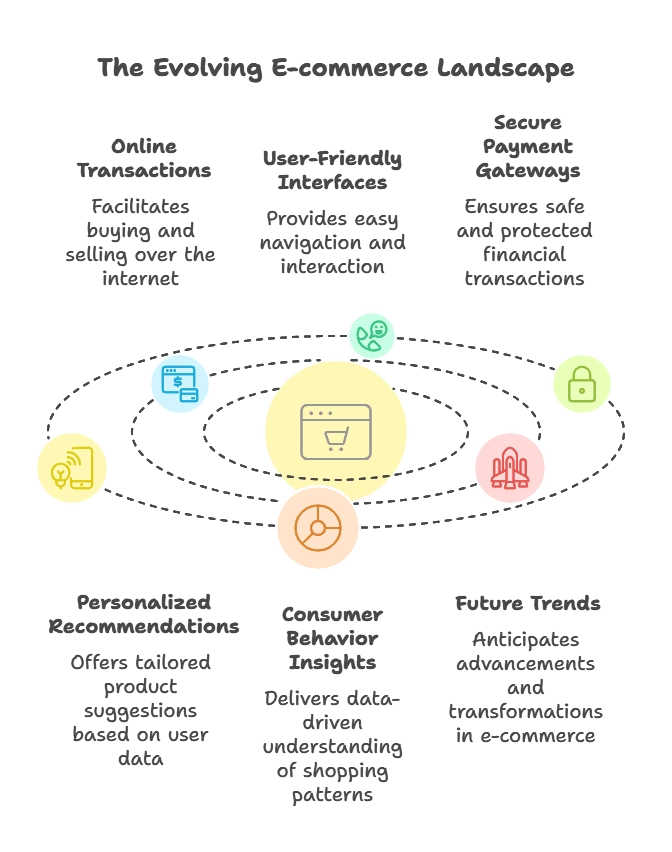Real world use cases
MongoDB is a NoSQL database known for its flexibility, scalability, and performance. It stores data in a JSON-like format called BSON (Binary JSON), which allows for a more dynamic and schema-less data structure. This chapter will explore various real-world use cases of MongoDB, from basic to advanced, and provide detailed examples and explanations.
E-Commerce Applications

Product Catalogs
Product catalogs in e-commerce applications need to handle a wide variety of items, each with different attributes. MongoDB’s flexible schema is perfect for this use case.
Example:
Consider an e-commerce platform that sells electronics, clothing, and books. Each product type has different attributes:
{
"_id": ObjectId("507f191e810c19729de860ea"),
"name": "Laptop",
"category": "Electronics",
"brand": "BrandX",
"specs": {
"processor": "Intel i7",
"RAM": "16GB",
"storage": "512GB SSD"
},
"price": 1200,
"inStock": true
}
{
"_id": ObjectId("507f191e810c19729de860eb"),
"name": "T-Shirt",
"category": "Clothing",
"brand": "BrandY",
"size": ["S", "M", "L", "XL"],
"color": "Red",
"price": 20,
"inStock": true
}
Code Example:
To query the database for all products in the “Electronics” category:
db.products.find({ category: "Electronics" })
// Output
[
{
"_id": ObjectId("507f191e810c19729de860ea"),
"name": "Laptop",
"category": "Electronics",
"brand": "BrandX",
"specs": {
"processor": "Intel i7",
"RAM": "16GB",
"storage": "512GB SSD"
},
"price": 1200,
"inStock": true
}
]
Explanation:
- The first document represents an electronic item with specific attributes like
processor,RAM, andstorage. - The second document represents a clothing item with different attributes like
sizeandcolor.
User Profiles and Personalization
E-commerce platforms often need to store user profiles and preferences to provide personalized recommendations.
Example:
{
"_id": ObjectId("507f191e810c19729de860ec"),
"username": "john_doe",
"email": "john@example.com",
"preferences": {
"categories": ["Electronics", "Books"],
"brands": ["BrandX", "BrandZ"]
},
"orderHistory": [
{ "orderId": ObjectId("507f191e810c19729de860ed"), "date": "2024-01-01", "total": 1200 },
{ "orderId": ObjectId("507f191e810c19729de860ee"), "date": "2024-02-15", "total": 20 }
]
}
Explanation:
- The document includes user preferences and order history, allowing for personalized recommendations based on past purchases and interests.
Code Example:
To find users who prefer “Electronics”:
db.users.find({ "preferences.categories": "Electronics" })
// Output
[
{
"_id": ObjectId("507f191e810c19729de860ec"),
"username": "john_doe",
"email": "john@example.com",
"preferences": {
"categories": ["Electronics", "Books"],
"brands": ["BrandX", "BrandZ"]
},
"orderHistory": [
{ "orderId": ObjectId("507f191e810c19729de860ed"), "date": "2024-01-01", "total": 1200 },
{ "orderId": ObjectId("507f191e810c19729de860ee"), "date": "2024-02-15", "total": 20 }
]
}
]
Content Management Systems (CMS)
Blog Platforms
MongoDB is ideal for CMS applications like blog platforms, where articles can have varying structures.
Example:
{
"_id": ObjectId("507f191e810c19729de860ef"),
"title": "Introduction to MongoDB",
"author": "Jane Smith",
"content": "MongoDB is a NoSQL database...",
"tags": ["MongoDB", "Database", "NoSQL"],
"comments": [
{ "user": "alice", "comment": "Great article!", "date": "2024-03-01" },
{ "user": "bob", "comment": "Very informative.", "date": "2024-03-02" }
],
"publishedDate": "2024-02-25"
}
Explanation:
- The document includes the article’s title, author, content, tags, comments, and published date, allowing for a flexible structure.
Code Example:
To find articles tagged with “MongoDB”:
db.articles.find({ tags: "MongoDB" })
// Output
[
{
"_id": ObjectId("507f191e810c19729de860ef"),
"title": "Introduction to MongoDB",
"author": "Jane Smith",
"content": "MongoDB is a NoSQL database...",
"tags": ["MongoDB", "Database", "NoSQL"],
"comments": [
{ "user": "alice", "comment": "Great article!", "date": "2024-03-01" },
{ "user": "bob", "comment": "Very informative.", "date": "2024-03-02" }
],
"publishedDate": "2024-02-25"
}
]
Internet of Things (IoT)
Sensor Data Storage
IoT applications often require storage of large volumes of time-series data from sensors. MongoDB’s ability to handle large, varied data sets makes it an excellent choice.
Example:
{
"_id": ObjectId("507f191e810c19729de860f0"),
"deviceId": "sensor123",
"timestamp": "2024-04-01T10:00:00Z",
"temperature": 22.5,
"humidity": 45
}
Explanation:
- Each document represents a sensor reading with a timestamp, device ID, temperature, and humidity.
Code Example:
To retrieve all readings from a specific device:
db.sensorData.find({ deviceId: "sensor123" })
// Output
[
{
"_id": ObjectId("507f191e810c19729de860f0"),
"deviceId": "sensor123",
"timestamp": "2024-04-01T10:00:00Z",
"temperature": 22.5,
"humidity": 45
}
]
Financial Services
Transaction Data
Financial institutions can use MongoDB to store transaction data, which can be complex and voluminous.
Example:
{
"_id": ObjectId("507f191e810c19729de860f1"),
"transactionId": "txn1001",
"accountId": "acc12345",
"amount": 250.75,
"currency": "USD",
"transactionDate": "2024-05-10T15:30:00Z",
"details": {
"merchant": "StoreXYZ",
"location": "New York"
}
}
Explanation:
- The document includes transaction details such as transaction ID, account ID, amount, currency, date, and additional details like merchant and location.
Code Example:
To find transactions for a specific account:
db.transactions.find({ accountId: "acc12345" })
// Output
[
{
"_id": ObjectId("507f191e810c19729de860f1"),
"transactionId": "txn1001",
"accountId": "acc12345",
"amount": 250.75,
"currency": "USD",
"transactionDate": "2024-05-10T15:30:00Z",
"details": {
"merchant": "StoreXYZ",
"location": "New York"
}
}
]
Social Media Platforms
User Posts and Interactions
Social media platforms require flexible data models to store posts, likes, comments, and user interactions.
Example:
{
"_id": ObjectId("507f191e810c19729de860f2"),
"userId": "user123",
"content": "Loving the new features in MongoDB!",
"timestamp": "2024-06-01T12:00:00Z",
"likes": 150,
"comments": [
{ "user": "user456", "comment": "Me too!", "timestamp": "2024-06-01T12:05:00Z" },
{ "user": "user789", "comment": "It's awesome!", "timestamp": "2024-06-01T12:10:00Z" }
]
}
Explanation:
- The document includes user posts with content, timestamp, likes, and comments.
Code Example:
To find posts with more than 100 likes:
db.posts.find({ likes: { $gt: 100 } })
// Output
[
{
"_id": ObjectId("507f191e810c19729de860f2"),
"userId": "user123",
"content": "Loving the new features in MongoDB!",
"timestamp": "2024-06-01T12:00:00Z",
"likes": 150,
"comments": [
{ "user": "user456", "comment": "Me too!", "timestamp": "2024-06-01T12:05:00Z" },
{ "user": "user789", "comment": "It's awesome!", "timestamp": "2024-06-01T12:10:00Z" }
]
}
]
MongoDB’s flexibility and scalability make it suitable for a wide range of applications, from e-commerce and content management to IoT and financial services. Its schema-less nature allows for easy adaptation to changing requirements, and its robust querying capabilities provide powerful data retrieval options. By leveraging MongoDB's features, developers can build efficient, scalable, and dynamic applications that cater to diverse real-world use cases. Happy coding !❤️
